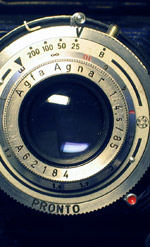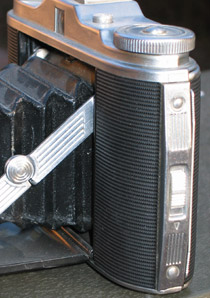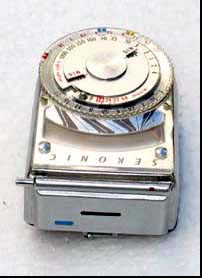Agfa Kamerawerk AG, Munchen, Germany

Depht of field indicator.

The calibration screw

Agfa Isolette I 6x6
"Landscape" format 6x6 and 4x4 folding cameras achieved a great popularity during the Fifties and Sixties. Due to the square negative format it doesn't matter which way you handle the camera but in practice it is more comfortable to hold it in a horizontal position.The Isolette series of cameras has a long history. The first Isolette was produced in 1938 and the last Super Isolette was made between 1954-1960. In the late Sixties 35mm cameras begun to take over. The Isolette I is an inexpensive German medium format folding camera sold between 1952 and 1960. This one might be one of the latest because the depth of field indicator is located opposite to the rewind knob.
The more featured and more "collectible" models like Super Silette has also a rangefinder.
Generally vintage Agfa Isolette cameras are functioning OK. However you may find the focusing to be quite sticky. This is caused by a hardened lubricant and / or some corrosion of the used materials and is considerably easy to repair. |
 Specifications Specifications
- Film type 120 Roll Film
- Picture size 6 x 6cm
- Lens Agfa Agnar 85mm f/4.5 (3 elements, coated)
- Shutter Pronto 1/25 - 1/200 + B
(no duble exposure prevention)
- Flash sync X (and M at 1/25)
- Size 143 x 96 x 39mm (closed) 143 x 96 x 99 ( open)
- Weight ~520g
|
 |
Sekonic Selenium Exposure Meter
One of the most common Exposure Meters
during Sixties and even Seventies. Not very
expensive but reliable and accurate enough.
A bad point in these selenium meters is the
"fatique" of selenium which causes incorrect
readings. You have to calibrate the meter
every now and then. It helps a little.
More about Selenium meters HERE |
 |
|
©2004 Reijo Lauro